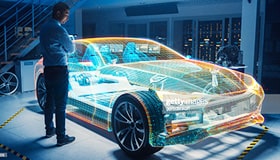The advantages and challenges of electric vehicles
The advantages and challenges of electric vehicles
As the world seeks to curb pollution and move to more sustainable forms of transport, many people are pinning their hopes on the success of electric vehicles (EVs).
In terms of greener transport, they certainly offer a number of benefits over those powered by internal combustion engines (ICEs). The principal one is the avoidance of the use of hydrocarbon based fossil fuels, the source of much of the manmade world’s production of greenhouse gases, as well as other serious pollutants such as carbon monoxide, nitrous oxide and airborne particulate matter.
In fact, in 2020, cars produced approximately 7.3 billion tonnes of CO2, a figure that accounted for some 41% of the total for the transport sector as a whole – by contrast, the focus of many peoples’ attention for emissions reduction, aviation, made up only eight percent of the total transport CO2 emissions. [1]
With many cities and local authorities seeking to discourage the use of ICE vehicles through setting up low emission zones, EVs carry the additional benefit for users of attracting zero charges to enter these zones. Other attractions for EV drivers include their lower running costs. On average, an electric car costs less than £1.30 to drive for 100 miles compared to £11.05 for a petrol powered car. [2]
Another advantage for environmentally conscious drivers is the renewable energy tariffs available from some electricity suppliers. EVs can also provide a better driving experience, with more responsive acceleration and motors that can benefit from regenerative braking to capture energy when slowing down. EVs also tend to have a lower centre of gravity due to storing heavy battery packs low in the body of the vehicle, improving handling, comfort and safety. They are also quieter than ICE vehicles, reducing the burden of noise pollution in towns and cities.
Mechanically, EVs are also much simpler, particularly purely battery driven vehicles with a completely electric drive train. With far fewer moving parts, there is less to go wrong.
As authorities try to encourage further uptake of EVs, they also often benefit from government grants. Free or dedicated parking is also often available for EVs in several cities as municipalities try to dissuade drivers from taking ICE vehicles into urban centres.
Alongside the carrot of monetary incentives, there is also the stick of prohibitive legislation - sales of new ICE powered vehicles are becomingly increasingly restricted or prohibited. Yet even here there is an advantage for users who make the switch early - with a complete ban in the UK from 2030, EVs will retain a better resale value as more drivers seek to access them in the absence of other options.
Challenges to EV adoption
As well as the benefits driving forward the adoption of EVs, there are also some barriers to their wider use. Four of the major ones are charging infrastructure, EV performances, availability and affordability.
Charging issues have been a major barrier to the expanding the popularity of EVs, with particular pain points for drivers being lack of infrastructure, slow charging speeds, the cost of chargers and the lack of charging standards. Drivers of EVs still suffer from range anxiety, the worry that the vehicle will run out of battery charge before they can reach another charging point.
This anxiety could be the reason why there is much greater interest in hybrid technology in most markets, significantly outstripping the interest in full Battery Electric Vehicles (BEVs) by some margin.
According to the Global Automotive Consumer study 2023 by Deloitte [3], most potential EV buyers expect to be able to charge their EVs at home and only 16% of potential EV purchasers in the United States anticipate using public chargers as their regular charging option. EV manufacturers are also asking for DC/DC charging compatibility to allow a 400V DC charger to charge an 800V battery to mitigate the gaps in the 800V charging network availability. This will aid market growth by offering a greater variety of charging options for drivers.
The time to charge an EV has also been cited as a drawback and much attention has been given to fast chargers that significantly reduce the wait, putting it on a par with refuelling an ICE vehicle. However, findings in the Deloitte report suggest this factor has been overstated, with drivers prepared to wait substantially longer than 10 minutes to recharge their batteries.
Performance is another challenge. The speed and torque output of a motor are inversely proportional and are limited by the total power output of the motor. This presents a challenge that is difficult to solve cost effectively.
Providing highly efficient power from the batteries to the vehicle’s loads is also increasingly important as comfort loads such as active suspension, heated seats and rear steering wheels are placing further demands on power.
Vehicle manufacturers are realizing that 12V architecture has been developed as far as it can be. They are now more willing to use innovative approaches to deliver better performance. EVs today still maintain a 12V battery to power non-traction related functions such as windscreen wipers, seat comfort controls, and infotainment.
Some manufacturers are replacing the 12V battery with a 48V unit for their latest models – the thinking is that, rather than rely on a separate 12V battery, why not create a virtual battery from the vehicle’s primary 400V or 800V battery pack? This allows manufacturers to save considerable weight in their vehicles, while also rationalising costs related to engineering, supply chains and the stocking of spare parts.
Other performance issues include battery capacity and the range they can provide. For example, battery capacities of current EVs range from a mere 17.6 kWh in the Smart EQ ForTwo with a range of just 58 miles, up to 100 kWh in the Tesla Model S that offers a maximum range of 351 miles.
Battery design, for example, is undergoing major innovation into new chemistries and methods of construction. Although these developments are still in their infancy, there are promising results already.
Battery swapping, a common concept in China, aims to avoid range anxiety by allowing electric cars to extend their range by exchanging a discharged battery for a charged one at a swapping station.
EVs employ over 50kW of electrical power, compared to less than 3kW in an ICE vehicle. The nearly 20 times increase in power requires compact power solutions to free up space and weight. Reducing the size and weight of the power delivery network are essential factors. For example, the Vicor BCM6135 delivers 2.5kW of power from a unit that weighs only 65 grams and which can be held in the palm of your hand.
The limited availability of electric vehicles is also among the major barriers to EV adoption. Today, there are only 29 fully electric consumer vehicle models available in North America. By contrast, there are more than 400 different models available in fuel-based alternatives.
The affordability issue is largely governed by the cost of the powertrain - 51% of total cost on average as compared to 18% of total cost for internal combustion engine powertrains. Efforts to reduce the size and weight of the power delivery network will be essential factors in the ultimate success of EVs.
Proving performance
The confidence of EV users is a major factor in the continuing take up of EVs – they need to know that electric vehicles have the range, performance, reliability and handling characteristics they demand.
This demands a rigorous testing regime with development engineers requiring specialised equipment for each testing use case.
The four major subsystems that manufacturers need to test are:
- Charging – of the battery, charging monitoring systems and regenerative braking
- Powertrain – the power inverter sub-system for power delivery, and its associated control signals
- Motors – three-phase brushless DC motors used in various applications such as windows and air conditioning
- Steering systems - Steering characteristics and electronic power steering
As well as research and development testing, there is a need to test electric vehicles during their production. This demands a new generation of more portable test equipment that allows in-car testing of different parameters in the field and which can operate in different climatic and road conditions.
Autonomous vehicles are also making increasing use of sensors that will also need maintenance, with specialist sensors such as LIDAR requiring equipment like optical spectrum analyzers to assess their performance and accuracy.
Conclusion
Despite the major advantages offered by EVs, challenges persist in such critical areas as vehicle charging time, driving range, and access to efficient EV charging stations. However, the mass electrification of transport is well under way. Engineers can meet the challenges with the technologies they have in place, but ultimately mass adoption and deployment will only be effective and profitable if governments and regulations support it and if EV vendors can ensure that users have the confidence in the vehicles that they need.
References
Stay informed
Keep up to date on the latest information and exclusive offers!
Subscribe now
Thanks for subscribing
Well done! You are now part of an elite group who receive the latest info on products, technologies and applications straight to your inbox.
Read more on:
Vibration sensor products and technologies
Using vibration analysis in predictive maintenance
How to implement MEMS sensors for vibration and condition monitoring
Smart Maintenance: The Evolution of Predictive MaintenanceRelated Article
- Charging protocols and safety standards for EV Charging Infrastructures
- The Future of EV Infrastructure: Navigating trends, opportunities, and benefits
- A Developer's Guide for designing the EV Charging using the right tool
- Revolutionizing Electric Vehicles - Innovations in Motor Control Systems
- How to implement Smart Metering in EV charging
- How to design an efficient power conversion circuit for EV Chargers
- Transforming Mobility: The Architecture and Solutions of V2X Communication in Electric Vehicles
- The effects of electric vehicle charging stations to the power grid
- Cyber security of public charging stations
- Powering Up with Safety and Ease: The Art of EV Charger Design
- EV Charging Standards: Ensuring Compatibility and Safety in the Charging Process
- EV charging and renewable energy for sustainable transportation
- EV Charging and Battery Management System
- Wireless Power Transfer: A Convenient and Efficient Solution for EV Charging
- Design Considerations for High-Efficiency EV Chargers
- The benefits and challenges of electric vehicles
- Communication network for electric vehicle charging
- How to boost Level-3 EV charging with the right connectivity
- How SPI isolated communication helps BMS in EVs









